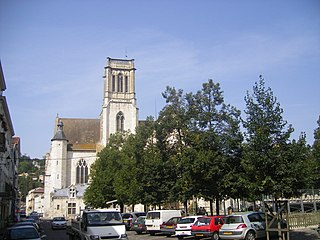Related Research Articles

The Roman Catholic Archdiocese of Reims is an archdiocese of the Latin Rite of the Roman Catholic Church in France. Erected as a diocese around 250 by St. Sixtus, the diocese was elevated to an archdiocese around 750. The archbishop received the title "primate of Gallia Belgica" in 1089.

The Roman Catholic Archdiocese of Lyon, formerly the Archdiocese of Lyon–Vienne–Embrun, is a Roman Catholic Metropolitan archdiocese in France. The Archbishops of Lyon serve as successors to Saint Pothinus and Saint Irenaeus, the first and second bishops of Lyon, respectively, and are also called Primate of the Gauls. He is usually elevated to the rank of cardinal. Bishop Olivier de Germay was appointed Archbishop of Lyon on 22 October 2020.

The Roman Catholic Diocese of Autun (–Chalon-sur-Saône–Mâcon–Cluny), more simply known as the Diocese of Autun, is a diocese of the Latin Rite of the Roman Catholic Church in France. The diocese comprises the entire Department of Saone et Loire, in the Region of Bourgogne.

The Roman Catholic Diocese of Agen is a Latin Rite Roman Catholic diocese in France.

The Roman Catholic Diocese of Valence (–Die–Saint-Paul-Trois-Châteaux) (Latin: Dioecesis Valentinensis ; French: Diocèse de Valence is a diocese of the Latin Church of the Roman Catholic Church in southern France. The contemporary diocese is co-extensive with the department of Drôme.

The Roman Catholic Archdiocese of Albi (–Castres–Lavaur), usually referred to simply as the Archdiocese of Albi, is a non-metropolitan archdiocese of the Latin Rite of the Catholic Church in southern France. The archdiocese comprises the whole of the department of Tarn, and has itself been suffragan, since the 2002 provinces reform, to the Archdiocese of Toulouse, a metropolitan archdiocese.

The Roman Catholic Diocese of Carcassonne and Narbonne is a diocese of the Latin Rite of the Roman Catholic Church in France. The diocese comprises the entire department of Aude. It is suffragan to the Archdiocese of Montpellier.

The Roman Catholic Archdiocese of Embrun was located in southeastern France, in the mountains of the Maritime Alps, on a route that led from Gap by way of Briançon to Turin. It had as suffragans the Diocese of Digne, Diocese of Antibes and Grasse, Diocese of Vence, Diocese of Glandèves, Diocese of Senez and Diocese of Nice. Its see was the Cathedral of Nôtre Dame in Embrun.

The former French Catholic diocese of Die existed from the fourth to the thirteenth century, and then again from 1678 to the French Revolution. It was suppressed by the Concordat of 1801, its territory being assigned to the diocese of Grenoble. Its see was the Cathedral of the Assumption in Die.

The former French Catholic diocese of Chalon-sur-Saône existed until the French Revolution. After the Concordat of 1801, it was suppressed, and its territory went to the diocese of Autun. Its see was Chalon Cathedral.

The Roman Catholic Diocese of Perpignan–Elne is a diocese of the Latin Rite of the Roman Catholic Church in France. The diocese comprises the Department of Pyrénées-Orientales. This see continues the old Diocese of Elne, which was renamed and had its see relocated at Perpignan, in 1601 after a papal bull of Pope Clement VIII. Its territory brought together the Diocese of Elne, part of the Spanish Diocese of Urgel known as French Cerdagne, three cantons of the Diocese of Alet, and two villages of the Diocese of Narbonne.

The Roman Catholic Diocese of Pamiers, Couserans, and Mirepoix is a diocese of the Latin Rite of the Roman Catholic Church in southern France. The diocese comprises the department of Ariège and is suffragan to the Archdiocese of Toulouse. The diocese of Pamiers is divided into five Deaneries: Pamiers, Foix, Haut-Ariège, Couserans, and Pays-d'Olmes-Mirapoix. The episcopal see is the Cathedral of Saint Antoninus in the city of Pamiers, and the current bishop is Jean-Marc Eychenne, appointed on 17 December 2014.

The Diocese of Lisieux was a Roman Catholic ecclesiastical territory in France, centered on Lisieux, in Calvados.

Blaundus was a Roman episcopal city in Asia Minor, presently Anatolia, and is now a Latin Catholic titular bishopric.
Helios, also known as Helios, Ælius or Helias, was the fourth bishop of Lyon. He is recognized as a saint by both the Orthodox Church and the Roman Catholic Church.
Faustin was the fifth bishop of Lyon. He is recognized as a saint by the Roman Catholic Church and the Orthodox Church.
Julius of Lyon was the seventh bishop of Lyon. He succeeded Verus in the second half of the 3rd century.

Gébuin was an archbishop of Lyon who served 1077 to 1082.
Priscus was a bishop of Lyon who exercised his office from 573 to sometime between 585 and 589.

Robert of Auvergne, also called Robert de la Tour, was a French nobleman, prelate and poet from the Auvergne. He served as bishop of Clermont from 1195 until 1227 and thereafter as archbishop of Lyon until his death. He was also a troubadour, composing poetry in Occitan.
References
- ↑ Bernard Berthod, Jacqueline Boucher, Bruno Galland, Régis Ladous et André Pelletier, Archevêques de Lyon, (Lyon, éditions Lyonnaises d'Art et d'Histoire, 2012) p191.
- ↑ Jacques Gadille (dir.), René Fédou, Henri Hours et Bernard de Vregille, Le diocèse de Lyon, Paris, Beauchesne, coll. « Histoire des diocèses de France » (no 16), 1983, p20.
| Catholic Church titles | ||
|---|---|---|
| Preceded by Ptolémaeus | Bishop of Lyon 4th century | Succeeded by Maximus |